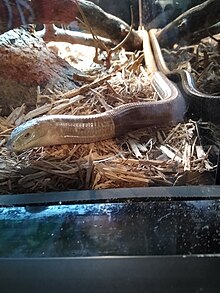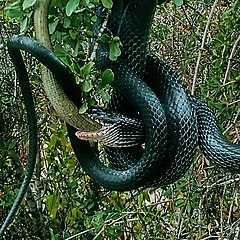Sheltopusik
This article includes a list of generalreferences,butit lacks sufficient correspondinginline citations.(November 2021) |
| Sheltopusik | |
|---|---|

| |
| Scientific classification | |
| Domain: | Eukaryota |
| Kingdom: | Animalia |
| Phylum: | Chordata |
| Class: | Reptilia |
| Order: | Squamata |
| Family: | Anguidae |
| Genus: | Pseudopus |
| Species: | P. apodus
|
| Binomial name | |
| Pseudopus apodus (Pallas,1775)
| |
| Synonyms[2] | |
Thesheltopusik[3]/ˌʃɛltəˈpjuːzɪk/(Pseudopus apodus), also commonly calledPallas's glass lizard,[4]theEuropean legless lizard,or theEuropean glass lizard,is aspeciesof largeglass lizardfound fromSouthern EuropetoCentral Asia.

Etymology
[edit]Pseudopus apoduscomes fromGreekψευδοποδος άποδος,literally meaning "fake-legged" or without legs.
The common name "sheltopusik" comes fromRussianжелтопузик(zheltopuzik), which translates most directly as "yellow-bellied".[5]
Taxonomy
[edit]The sheltopusik was previously included in thegenusOphisaurus,but has since been placed in its own genusPseudopus.It was originally described in 1775 byPeter Simon PallasasLacerta apoda.[6]
There are three subspecies:[7][8]
- P. a. apodus(Pallas, 1775)- the type subspecies, ranging fromCrimeathroughTranscaucasia,east toCentral Asiaas far asKazakhstan
- P. a. levantinusJablonski, Ribeiro-Junior, Meiri, Maza, Mikulíček & Janzik, 2021- restricted to theLevant,from southernTurkeysouth toIsraelandPalestine
- P. a. thracicus(Obst, 1978)- the westernmost subspecies, ranging fromCroatiatoGreece,east to western Turkey
Despite only being described in 2021,P. a. levantinusis the largest and most genetically diverse of the subspecies, indicating an older and more complex evolutionary history compared to its sister subspecies.[8]
Description
[edit]The sheltopusik can reach a length of 135 cm (4.43 ft). It is tan colored, paler on the ventral surface and the head, with a ring-like/segmented appearance that makes it look like a largeearthwormwith a distinctive fold of skin down each side called a lateral groove. Small (2-mm) rear legs are sometimes visible near thecloaca.Though the legs are barely discernible, the sheltopusik can be quickly distinguished from asnakeby itsears,eyelids, andventral scales.
Habitat and behaviour
[edit]P. apodusinhabits open country, such as short grassland or sparsely wooded hills. It consumesarthropodsand smallmammals.Snailsandslugsappear to be its favorite prey, which may explain why it is particularly active in wet weather, although it prefers a dry habitat. Breaking through the shells of snails is an especially easy task due to their teeth and jaw structure.
Defensive behaviour
[edit]Due to its size, the sheltopusik tends to respond to harassment by hissing, biting, and musking. It is less likely to drop off its tail than some other species that display caudalautotomy.However, these occasional displays of caudal autotomy are responsible for the name "glass lizard"(or" glass snake "). The released tail may break into pieces, leading to the myth that the lizard can shatter like glass and reassemble itself later. In reality, if the tail is lost, it grows back slowly, but is shorter and darker. The replacement tail may grow back to full length after an extended period of time.


In captivity
[edit]Sheltopusiks are frequently available in the exotic pet trade, though rarely captive-bred. They do not typically tolerate a large amount of handling, but they adapt to captivity well, feeding oncrickets,meal worms,smallmice,eggs, snails, or pieces of meat. They are even known to accept these meals from a keeper'stweezers,or even from their hands once they become used to captivity. However, sheltopusiks do get excited around food and have surprisingly powerful jaws. They make hardy captives, capable of living up to 50 years.
Reproduction
[edit]About 10 weeks after mating, the femaleP. apoduslays about eight eggs, which she hides under bark or a stone, and often guards them. The young hatch after 45 to 55 days. They are typically about 15 cm (5.9 in) long and usually start to eat after four days.
Relationship with humans
[edit]Remains of the Levant subspecies (P. a. levantinus) are known fromNatufiansites inIsrael,suggesting that it was eaten by the local population at the time.[8][9]
References
[edit]- ^Aghasyan, A.; Avci, A.; Tuniyev, B.; Crnobrnja-Isailovic, J.; Lymberakis, P.; Andrén, C.; Cogalniceanu, D.; Wilkinson, J.; Ananjeva, N.B.; Üzüm, N.; Orlov, N.L.; Podloucky, R.; Tuniyev, S.; Kaya, U.; Disi, A.M.; Hraoui-Bloquet, S.; Sadek, R.; Tok, V.; Ugurtas, I.H.; Sevinç, M.; Haxhiu, I.; Borkin, L.; Shestapol, A.; Dujsebayeva, T.; Golynsky, E.; Chirikova, M.; Nuridjanov, D. (2021)."Pseudopus apodus".IUCN Red List of Threatened Species.2021:e.T157263A745759.doi:10.2305/IUCN.UK.2021-3.RLTS.T157263A745759.en.Retrieved20 February2022.
- ^"Pseudopus apodus".The Reptile Database. www.reptile-database.org.
- ^Also spelledscheltopusik,sheltopusick,scheltopusick,sheltopusic,orscheltopusic.
- ^Beolens, Bo; Watkins, Michael; Grayson, Michael (2011).The Eponym Dictionary of Reptiles.Baltimore: Johns Hopkins University Press. xiii + 296 pp.ISBN978-1-4214-0135-5.(Pseudopus apodus,p. 199).
- ^Н. Б. Ананьева (2004).Атлас пресмыкающихся Северной Евразии: таксономическое разнообразие, географическое распространение и природоохранный статус.Зоол. инст. РАН.ISBN978-5-98092-007-4.
- ^Lacerta apoda.Peter Simon Pallas. Published:1775.
- ^"Pseudopus apodus".The Reptile Database.Retrieved2022-08-03.
- ^abcJablonski, Daniel; Ribeiro-Júnior, Marco Antônio; Meiri, Shai; Maza, Erez; Kukushkin, Oleg V.; Chirikova, Marina; Pirosová, Angelika; Jelić, Dušan; Mikulíček, Peter; Jandzik, David (2021-05-04)."Morphological and genetic differentiation in the anguid lizard Pseudopus apodus supports the existence of an endemic subspecies in the Levant".Vertebrate Zoology.71:175–200.doi:10.3897/vz.71.e60800.ISSN2625-8498.S2CID233422513.
- ^Schuster, Ruth."Lizards Eaten by Prehistoric People in Today's Israel Were Unknown Subspecies".Haaretz.
External links
[edit]- "The Scheltopusik,Pseudopus[Ophisaurus]apodus:Natural History and Care ".Cyber Lizard U.K. 2003-09-28.Retrieved2008-01-19.
- "Scheltopusik Care Sheet and Information".Western New York Herpetological Society. 2008.Retrieved2008-01-19.
- Kaplan, Melissa (1997)."Glass Lizard - Glass Snake - Legless Lizard".Melissa Kaplan's Herp Care Collection.Retrieved2008-01-19.
- "European Glass Lizard".Wild Natures. September 2006. Archived fromthe originalon 2008-04-02.Retrieved2008-01-19.
- "Giant Legless Lizard".Central Pets. 2008-01-19. Archived fromthe originalon 2007-10-16.Retrieved2008-01-19.
Further reading
[edit]- Arnold EN,Burton JA (1978).A Field Guide to the Reptiles and Amphibians of Britain and Europe.London: Collins. 272 pp. + Plates 1-40. (Ophisaurus apodus,pp. 175, 178 + Plate 33, figures 1a-1b + Map 94).
- Boulenger GA(1885).Catalogue of the Lizards in the British Museum Natural History). Second Edition. Volume II.... Anguidæ...London: Trustees of the British Museum (Natural History). (Taylor and Francis, printers). xiii + 497 pp. + Plates I-XXIV. (Ophisaurus apus,new combination, pp. 280–281).
- Pallas PS(1775). "Lacerta apoda, descripta".Novi Comentarii Academiae Scientiarum Imperialis Petropolitanae19:435-454 + Plates IX-X. (Lacerta apoda,new species). (in Latin).

